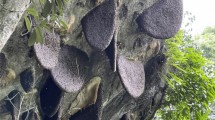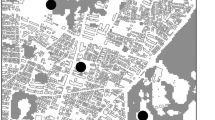Summary
This is a first behavioural description of a large non-nest associated drone congregation of the stingless beeMelipona favosa. The about 400 drones had originated from different nests. The males interacted aggressively. Several gynes arrived at the drone congregation area (DCA). Olfactory stimuli triggered specific behaviours of the males as well as of the gynes but matings were not observed at the DCA.
Similar content being viewed by others
References
Eickwort, G. S. and H. S. Ginsberg, 1980. Foraging and mating behavior in Apoidea.Ann. Rev. Entom. 25:421–446.
Engels, E. and W. Engels, 1984. Drohnen-Ansammlungen bei Nestern der Stachellosen BieneScaptotrigona postica.Apidologie 15:315–328.
Engels, E. and W. Engels, 1988. Age-dependent queen attractiveness for drones and mating in the stingless bee,Scaptotrigona postica.J. Apic. Res. 27:3–8.
Engels, W. and V. L. Imperatriz-Fonseca, 1990. Caste development, reproductive strategies, and control of fertility in honey bees and stingless bees. In:Social Insects, and evolutionary approach to castes and reproduction (W. Engels, Ed.) Springer-Verlag, Berlin, pp. 167–230.
Imperatriz-Fonseca, V. L., 1977. Studies onParatrigona subnuda II Behaviour of the virgin queen.Bolm. Zool. S. Paulo 2:169–182.
Kerr, W. E., R. Zucchi, J. T. Nakadaira and J. E. Botolo, 1962. Reproduction in the social bees (Hymenoptera: Apidae).J. N. Y. Entom. Soc. 70:265–276.
Michener, C. D., 1946. Notes on the habits of some Panamanian stingless bees.J. N. Y. Entom. Soc. 54:179–197.
Roubik, D. W., 1983. Nest and colony characteristics of stingless bees from Panama (Hymenoptera: Apidae).J. Kansas Entomol. Soc. 56:327–355.
Roubik, D. W., 1990. Reproductive ecology of stingless bees: observations onTetragona and meate competition (Hymenoptera: Apidae, Meliponinae).Entologolie Generale 15:115–120.
Ruttner, F. and H. Ruttner, 1972. Untersuchungen über die Flugaktivität und das Paarungsverhalten der Drohnen. 5. Drohnensammelplätze und Paarungsdistanz.Apidologie 3:203–232.
Sommeijer, M. J., J. W. van Veen and R. Sewmar, 1990. The intranidal acitivty of males ofMelipona with some remarks about male production in stingless bees.Actes Coll. Ins. Soc. 6:63–67.
Sommeijer, M. J. and N. W. M. van Buren, 1992. Male production by laying workers in queenright colonies ofMelipona favosa (Apidae, Meliponinae). In:Biology and Evolution of Social Insects (J. Billen, Ed.), Leuven University Press. Leuven, pp. 89–98.
Veen, J. W. van, H. Arce and M. J. Sommeijer, 1990. Production of males in colonies ofMelipona beecheii, Costa RicaAct. Coll. Ins. Soc. 6:57–62.
Author information
Authors and Affiliations
Rights and permissions
About this article
Cite this article
Sommeijer, M.J., de Bruijn, L.L.M. Drone congregations apart from the nest inMelipona favosa . Ins. Soc 42, 123–127 (1995). https://doi.org/10.1007/BF01242448
Received:
Revised:
Accepted:
Issue Date:
DOI: https://doi.org/10.1007/BF01242448




